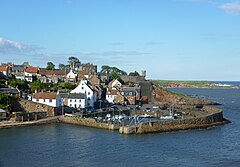Crail, Fife
Crail
|
|
|---|---|
 |
|
| Crail shown within Fife | |
| Population | 1,639 |
| OS grid reference | NO613078 |
| Council area | |
| Lieutenancy area | |
| Country | Scotland |
| Sovereign state | United Kingdom |
| Post town | ANSTRUTHER. |
| Postcode district | KY10 |
| Dialling code | 01333 |
| Police | Scottish |
| Fire | Scottish |
| Ambulance | Scottish |
| EU Parliament | Scotland |
| UK Parliament | |
| Scottish Parliament | |
Crail (![]() listen ); Scottish Gaelic: Cathair Aile) is a former royal burgh, parish and community council area (named Royal Burgh of Crail and District) in the East Neuk of Fife, Scotland.
listen ); Scottish Gaelic: Cathair Aile) is a former royal burgh, parish and community council area (named Royal Burgh of Crail and District) in the East Neuk of Fife, Scotland.
The civil parish has a population of 1,812 (in 2011).
Crail probably dates from at least as far back as the Pictish period, as the place-name includes the Pictish/Brythonic element caer, 'fort'. According to Crail Parish Church's website (see external link below), the site on which the parish church is built appears to have religious associations that pre-date the parish church's foundation in early mediaeval times, as evidenced by a Dark Age cross-slab preserved in the church. The parish church was itself dedicated (in the 13th-century) to the early holy man St. Maelrubha of Applecross in Wester Ross.
Crail became a Royal Burgh in 1178 in the reign of King William the Lion.Robert the Bruce granted permission to hold markets on a Sunday, in the Marketgait, where the Mercat Cross now stands in Crail. This practice was still continuing in the 16th century, causing concern in the freshly puritanical circles of Edinburgh such that John Knox, visiting Crail on his way to St Andrews in 1559, was moved to deliver a sermon in Crail Parish Church, damning the fishermen of the East Neuk for working on a Sunday. (See Crail Parish Church website: external link below.) Despite the protests, the markets continued and were amongst the largest in Europe for their time.
...
Wikipedia

